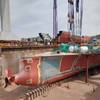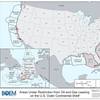Hydrogen sulfide (H2S) has been called the "silent killer" because it has a way of sneaking up on its victims and killing them without warning. The key to protecting crewmen against the silent killer is to raise their awareness by educating them about the dangers of H2S and the precautions necessary to work with it safely.
Hydrogen sulfide is a toxic gas most often encountered as a residual contaminant in cargoes such as crude oil, #6 oil, and molten sulfur. Hydrogen sulfide can also be encountered in holds containing decomposing plant and animal materials. Ballast tanks sometimes contain hydrogen sulfide because of the decomposition of plant and animal material contained in river water.
Properties and Characteristics
In order to work safely around Hydrogen sulfide, workers must be aware of its properties and characteristics. Hydrogen sulfide has a combination of properties and characteristics making it a particularly difficult hazard to deal with.
This extremely toxic gas produces signs and symptoms of exposure varying with concentration. The Occupational Safety and Health Administration consider concentrations as low as 10 PPM, or.001% by volume, unhealthy.
Short-term exposures to concentrations between 10 and 100 PPM can cause mild eye and respiratory tract irritation, headaches, and nausea; Short-term exposure to concentrations between 100 PPM and 400 PPM can cause serious eye and respiratory tract irritation, headaches, nausea, disorientation, and gastrointestinal disturbances. Exposures for a period for hours at this concentration can cause some people to develop pulmonary edema, or chemical pneumonia.
Loss of consciousness, resulting from respiratory arrest, can occur with short-term exposure to concentrations of H2S above 400 PPM. H2S causes respiratory arrest by disrupting the signals sent by the nerves in the brain that control breathing. Between 400 PPM and 700 PPM respiratory arrest can take minutes or hours to develop; however, at concentrations over 700 PPM, respiratory arrest can result from one breath. If the victim is not rescued and resuscitated within three to six minutes, permanent brain damage or death will result.
Under certain circumstances, individuals can experience the signs and symptoms of hydrogen sulfide exposure at lower concentrations than those presented above. Factors that might make an individual more susceptible to hydrogen sulfide include:
· previous exposure to hydrogen sulfide, within the last 24 hours;
· use of alcohol, drugs, and certain prescription medications, within the last 24 hours;
· health problems involving the respiratory, circulatory, or nervous systems; and
· personal biochemistry.
Because medications and health problems can result in sensitivity to hydrogen sulfide, it is important for companies to establish guidelines concerning the medical evaluation of personnel assigned to work with cargoes that may contain hydrogen sulfide.
Another dangerous property of Hydrogen sulfide is its poor warning characteristics. H2S is difficult to detect because it is invisible and has a variable odor. At low concentrations, H2S has an odor similar to rotten eggs and at slightly higher concentrations may have a sweet or metallic odor. At concentrations above 100 PPM concentrations, H2S deadens the olfactory nerves and has no odor at all, which is why instrumentation must be used to detect H2S instead of the sense of smell.
H2S is also dangerous because it is flammable. Its temperature of ignition is very low at 518 degrees F. The minimum concentration of H2S that will burn is 4.3 percent or 43,000 PPM; the maximum concentration, which will burn, is 46 percent or 460,000. When H2S burns, it forms another very toxic gas, sulfur dioxide. Sulfur Dioxide is intensely irritating and has an easily detected burnt match smell.
Another reason H2S is particularly dangerous is it is 19 percent heavier than air, when compared to air at the same temperature. This causes H2S to settle and accumulate in the breathing zone of workers, which is a particular problem when the weather is calm and cool.
The fact hydrogen sulfide is corrosive also presents a problem. The gas is particularly corrosive to iron, copper, and silver - metals used extensively in circuit boards. Unless protected in gas-tight enclosures, electronic equipment has a high failure rate in H2S atmospheres.
Precautions Necessary to Work Safely with H2S
H2S is a common hazard in the industry and the precautions necessary to work safely around H2S are well understood. Safely working around H2S requires six precautions:
· contingency planning;
· engineering controls;
· personal protective equipment;
· gas detection equipment;
· safe work practices; and
· emergency response plans.
A Hydrogen sulfide contingency plan is a systematic analysis of the hazards associated with an operation and the methods required to reduce the hazards to an acceptable level. The Declaration of Inspection form is a tool that must be used when developing job-specific contingency plans.
Engineering controls are features incorporated into equipment to reduce or eliminate hazards.
Containment is one of the primary engineering controls used to protect personnel. On conventional barges, closed hatches exclude Hydrogen sulfide from the work environment while the tow is underway. Since the hatches on conventional barges must be opened during transfers, containment is not an effective engineering control during loading and unloading. On vapor recovery barges, containment protects workers from Hydrogen vapor recovery barges while underway and during cargo transfers.
Ventilation is another engineering control used to protect workers. When even a light wind is blowing, natural ventilation can greatly reduce the concentrations of Hydrogen sulfide in the work environment. Fans and chimneys are sometimes incorporated into loading facilities and barges, to provide ventilation. Chimneys are designed to discharge vapors and gases well above the breathing zone of workers where they are rapidly dispersed once they are discharged. Because chimneys rely on the natural tendency for hot gases to rise, the air intakes in the cargo hold must be carefully managed to obtain maximum efficiency.
Often, engineering controls are not economically or technologically feasible and cannot be used. Personnel protective equipment, such as respirators, must be used. Respiratory protection is necessary to protect personnel in work environments where more than 10 PPM hydrogen sulfide is present. Due to its high toxicity and poor warning characteristics, the only form of respiratory protection acceptable when Hydrogen sulfide is present is the Self-Contained Breathing Apparatus. Three main types of SCBA's used on the inland waterway are the five-min. escape unit, the five-min. hoseline work unit, and the 30-min. work/rescue SCBA.
Portable gas detection equipment is often used in determining when SCBA's are necessary. Gas detection equipment is important when working around Hydrogen sulfide since it has such poor warning characteristics. Three types of gas detection equipment are commonly used to detect hydrogen sulfide: lead acetate tapes, colormetric tubes, and portable electronic detectors. Portable electronic gas detectors are particularly useful when working with cargoes containing H2S since they are designed to warn workers of the presence of Hydrogen sulfide by automatically sounding an alarm.
To be effective in protecting workers, engineering controls, personal protective equipment, and gas detection equipment must be used in conjunction with safe work practices. Although there are certain generic safe work practices - such as working on the upwind side of areas where H2S is potentially present - the safe work practices necessary to protect workers from H2S are often job-specific. These are best identified by having a team of knowledgeable workers perform a job hazard analysis on the tasks to be performed.
A well thought-out Emergency Response Plan is one of the most important precautions needed to work safely around H2S. When all other precautions fail, the Emergency Response Plan is the H2S victim's last hope. The Emergency Response Plan must be developed and practiced before it is needed because plans developed on the spur of the moment often result in rescuers getting killed.
An effective Emergency Response Plan will allow rescuers to safely enter an atmosphere containing H2S, recover the victim, and resuscitate them within three minutes. An expedient rescue is essential since brain damage will start to occur in victims that have been in respiratory arrest for longer than three minutes.
An excellent video on hydrogen sulfide safety entitled, "Hydrogen Sulfide Safety for the Inland Waterways and Maritime Personnel" is available from Moxie Media. Information on this video is available at 504-733-6907 or http://www.moxietraining.com
Charles Simpson, CSP, is a New Orleans-based consultant, specializing in safety issues related to hazardous chemicals. He can provide assistance with training and the development of written safety programs. Contact him at Safety Consulting Associates; tel: 504-624-8060
Sponsored Content
MSC Sets a New Standard for Time Off in 2025, Plus Earn a $38,340 Bonus as an Able Seaman!

Navigate Compliance with Confidence: Discover Carbon Diligence from ABS Wavesight

Featured videos

Xenos Marine Takes Aim at the Gulf Salvage, Decommissioning Markets

AI to the Rescue: Zelim’s ZOE to be Installed on Cruise Ship
April 2025
 Read the Magazine
Read the Magazine

 Read the Magazine
Read the Magazine
This issue sponsored by:

Crowley Builds the Future Maritime & Logistics Workforce
Subscribe for
Maritime Reporter E-News
Maritime Reporter E-News is the maritime industry's largest circulation and most authoritative ENews Service, delivered to your Email five times per week









